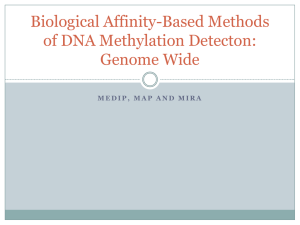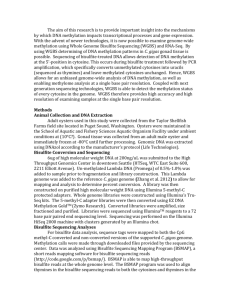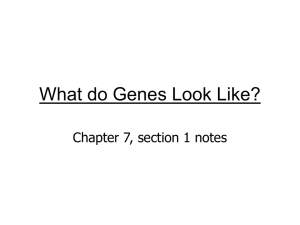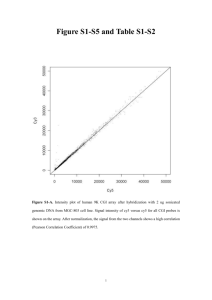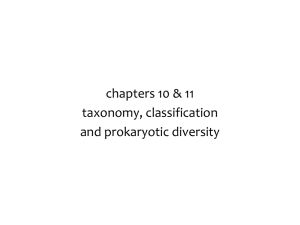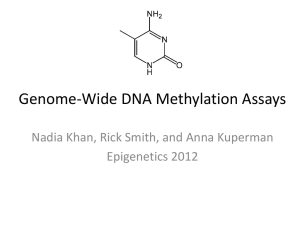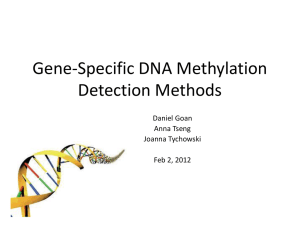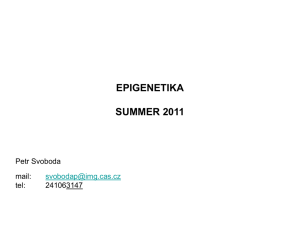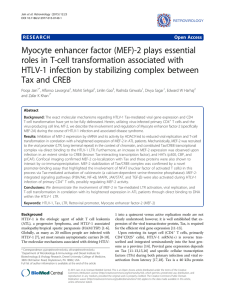Epigenetics Presentation_TB_AB
advertisement
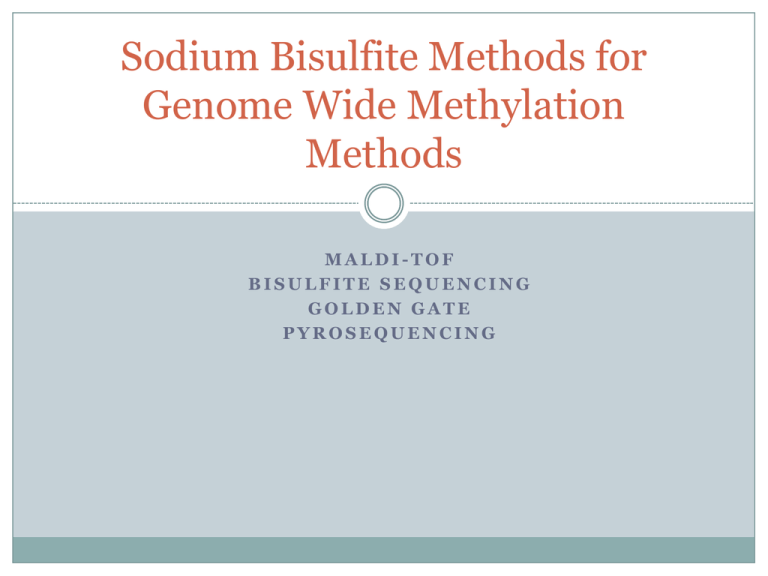
Sodium Bisulfite Methods for Genome Wide Methylation Methods MALDI-TOF BISULFITE SEQUENCING GOLDEN GATE PYROSEQUENCING The basic principle is the fact that sodium bisulfite deaminates non-methylated cytosines to uracil while 5-methylcitosines are resistant. Tollefsbol 2011 Bisulfite sequencing can be targeted or genomewide CpGs CpGs MS Targeted -Reduced Representation Bisulfite Sequencing (RRBS) (uses restrictions enzymes MspI: 5’CCGG3’) -Molecular Inversion Probes (MIP) (Padlock Probes) Genome-wide: This is most important standard to examine a tissue- or cell type-specific methylome Some studies covered 22% of the CpG sites in chromosome 20 and 22 in 12 human tissues Weichenhan and Plass, 2013 Targeted Bisulfite Sequencing Padlock capture This method simultaneously captures and amplifies large numbers of regions of interest from genomic DNA. Each padlock probe contains two complementary sequences that hybridize a region of interest. The motifs are linked by a loop of DNA that guarantees efficient hybridization and has universal motifs for PCR universal primers. Combined with NGS, it has been able to achieve 90–99% of target specificity in mammalian methylomes. Laird 2010 Other bisulfite based methods are: MALDI-TOF: Matrix-assisted laser desorption/ionizationTime-of-flight mass spectrometry Tollefsbol 2011 Genome-wide approaches Voelkerding et al 2009 Next gene sequencing platforms Roche 454 ABI/SOLiD Illumina/Solexa NGS isn’t perfect. It’s cheap and reliable but can be computationally expensive. Voelkerding et al 2009 Pyrosequencing Sequencing by synthesis, this system detects pyrophosphates by luminotropic detection when they are released upon nucleotide incorporation. Tost and Gut, 2007 Illumina GoldenGate (and Infinium assay) Is an Array-based method which is excellent for characterizing and analyzing large numbers of samples Illumina Inc, 2010 Plot of sample size vs genome coverage for a diverse set of DNA methylation techniques Laird 2010 Biological Affinity-Based Methods of DNA Methylation Detecton: Genome Wide MEDIP, MAP AND MIRA The Basic Idea Some antibodies have a high affinity for methylated DNA, or methylation-specific proteins, which means that they will bind to methylated sites on DNA, but not to non-methylated sites DNA is sheared via sonication (aka, ultra-sound vibration), purified, and treated with those antibodies This follows the same basic methodology as on the gene-specific scale, but use of micro-arrays and parallel sequencing gives a genome-wide result MeDIP Acronym, stands for Methylated DNA Immunoprecipitation Genomic DNA is extracted, sonicated, denatured, incubated with monoclonal 5mC antibodies, which bind to the methylated cytosines, and is classically immunoprecipitated: bound DNA is separated from unbound DNA, and from here, several different methods can be used to quantify ‘enrichment’ MeDIP (cont.) One way to quantify enrichment is by comparison to the original genome, using a high density microarray –Basically, some of the original genomic material is labeled with red cytosines while the enriched DNA is labeled with green cytosines, which make for a visible comparison Another is to run the enriched DNA through a highthroughput sequencer and compare it to the original DNA How to MeDIP MAP Surprisingly, another acronym. Stands for MBD Affinity Purification This method uses Methyl CpG binding Proteins, variable called MBDs, MeCPs, etc., which binds to methylated CpGs and not DNA Basically the same method as MeDIP but without immunoprecipitation or high-throughput sequencing comparisons Comparison is conducted by analyzing percentage of methylated-unmethylated DNA How to MAP MIRA One last acronym, stands for Methylated CpG Island Recovery Assay Uses a hybrid MBD protein (MBD2b and MBD3L1) to bind to methylated sites on DNA Same basic method as MeDIP, only the DNA needn’t be denatured, since the hybrid MBD has a high methyl-affinity Again, similar to MeDIP, this is conducted on a genespecific scale as listed, but on a genome-wide scale via micro-array; must use PCR reactions to amplify the tiny amount of DNA used How to MIRA Pros/Cons MeDIP – Pros: Fast, cheap, works easily with large scale analysis; Cons: DNA must be single-stranded, must have quality enzymes or risk false-data, method has inherent bias for specific sequences MAP – Pros: Outdated and thus cheap, works easily and quickly with large scale, relatively easy (computationally); Cons – outdated, needs a large amount of DNA to work with, same inherent bias MIRA – Pros: Low false-positive rate, sensitive, needs very little material to work with; Cons- Low sensitivity in CpG poor regions, limited by MBD binding ability, which, again, has an inherent bias Issues with Biological Affinity Recently, it was discovered that several variants of cytosine exist, one of them, 5-hmC (in contrast to 5mC) in mammalian cells. Most techniques, including MeDIP, MIRA and MAP, do not distinguish one from the other, leading to incorrect assessments of overall genomic methylation Solution: commerical application of PvuRst1, an enzyme capable of making that distinction OR BetaGlucosyltransferase enzyme, which tags hmC’s with sugar to create a distinction References LAIRD, P. W. (2010). PRINCIPLES AND CHALLENGES OF GENOMEWIDE DNA METHYLATION ANALYSIS. NATURE REVIEWS. GENETICS, 11(3), 191–203. DOI:10.1038/NRG2732 TOST, J., & GUT, I. G. (2007). DNA METHYLATION ANALYSIS BY PYROSEQUENCING. NATURE PROTOCOLS, 2(9), 2265–75. DOI:10.1038/NPROT.2007.314 VOELKERDING, K. V, DAMES, S. A, & DURTSCHI, J. D. (2009). NEXTGENERATION SEQUENCING: FROM BASIC RESEARCH TO DIAGNOSTICS. CLINICAL CHEMISTRY, 55(4), 641–58. DOI:10.1373/CLINCHEM.2008.112789 WEICHENHAN, D., & PLASS, C. (2013). THE EVOLVING EPIGENOME. HUMAN MOLECULAR GENETICS, 22(R1), R1–6. DOI:10.1093/HMG/DDT348
